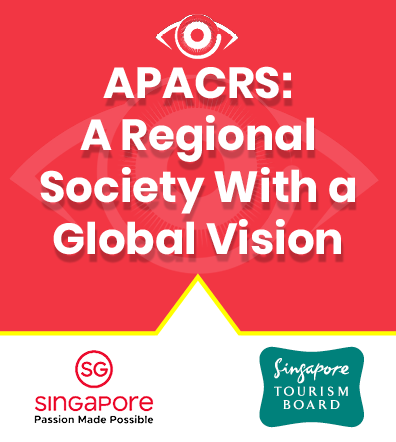Eyeworld Weekly Update |
Volume 20, Number 18 |
15 May 2015 |
- Glaukos files for proposed initial public offering
- iDesign approved for LASIK procedures
- EBI-005 demonstrated 'clinically relevant effect' in dry eye
- TGF-β isoforms showing promise in glaucoma treatment
- Humira met primary endpoints in uveitis study
- Patient recruitment in pivotal p3 for Fovista complete
Glaukos files for proposed initial public offering
Glaukos Corporation (Laguna Hills, Calif.) announced that it has filed a registration statement on Form S-1 with the Securities and Exchange Commission (SEC), relating to the proposed initial public offering (IPO) of its common stock.
"The number of shares to be offered and the price range for the proposed offering have not yet been determined," company officials said in a press release. Glaukos has applied to list its common stock on The New York Stock Exchange under the symbol "GKOS."
The company entered the MIGS space with the first device approved by the FDA for the U.S. market, the iStent.
iDesign approved for LASIK procedures
The iDesign Advanced Wavescan Studio system for use in LASIK procedures has received U.S. regulatory approval, marketer Abbott Medical Optics (Santa Ana, Calif.) said. According to AMO, the wavefront diagnostic aberrometry is able to detect imperfections in the eye that result in poor vision with high-definition scanning technology. The scan captures 5 different optical measurements, enabling the surgeon to provide a more customized LASIK treatment specifically tailored to the patient's eye. The 3-second scan produces a 3D image 'blueprint' of the eye, the company added. In addition, the technology can allow surgeons to better screen patients who were not previously candidates for LASIK.
Abbott plans to fully launch the iDesign system in the United States in June 2015.
EBI-005 demonstrated 'clinically relevant effect' in dry eye
A novel, protein therapeutic, which is in late-stage clinical development for dry eye disease and allergic conjunctivitis, has shown "a clinically relevant effect in dry eye disease and clinically relevant, statistically significant improvements in ocular itching, ocular tearing and nasal symptoms associated with the late phase allergen response utilizing a modified direct conjunctival allergen model in patients with allergic conjunctivitis," developer Eleven Biotherapeutics (Cambridge, Mass.) said in a news release.
EBI-005 is the first IL-1 (Interleukin-1) receptor inhibitor designed for topical ocular administration.
According to the company, top-line pivotal phase 3 results for EBI-005 in dry eye disease are expected later this quarter and Eleven Biotherapeutics will be initiating a phase 3 study with EBI-005 in allergic conjunctivitis in the second half of this year.
TGF-β isoforms showing promise in glaucoma treatment
ISTH0036, a locked nucleic acid-modified antisense oligonucleotide, showed promising preclinical results for the treatment of advanced-stage glaucoma, developer Isarna (Munich, Germany) said in a news release.
ISTH0036 was administered to evaluate its therapeutic potential in murine models of glaucoma filtration surgery (GFS) and laser-induced choroidal neovascularization (CNV). In the murine GFS model, upon intraocular administration, ISTH0036 was able to significantly prolong bleb survival, as compared to control oligonucleotide- and saline-treated eyes. In addition, ISTH0036 was able to significantly decrease the extent of fibrosis in the bleb area in a sequence-specific manner, Isarna added.
An intravitreal administration of ISTH0036 in a CNV murine model was able to significantly reduce (40%) the process of angiogenesis, as compared to saline- and control oligonucleotide-treated eyes, the company added.
Humira met primary endpoints in uveitis study
A phase 3 study investigating the efficacy and safety of Humira (adalimumab, Abbvie, Chicago) in adult patients with active non-infectious intermediate, posterior, or panuveitis who still experienced intraocular inflammation while on systemic corticosteroid therapy found the biologic "significantly" lowered patients' risk of uncontrolled uveitis or vision loss, marketer Abbvie said in a news release.
The VISUAL-I study found that compared to placebo, patients on Humira were less likely to experience treatment failure (TF) (P<0.001). Median time to TF was prolonged by 87%, from 3 months for placebo to 5.6 months for Humira. TF is a multi-component outcome based on chorioretinal or vascular lesions, best corrected visual acuity, anterior chamber cell grade, and vitreous haze (VH) grade.
AbbVie is also evaluating the safety and efficacy of Humira in patients with inactive, non-infectious intermediate, posterior, or panuveitis, in the ongoing Phase 3 VISUAL II clinical trial and those results are "expected soon."
Patient recruitment in pivotal p3 for Fovista complete
Patient enrollment in the first of three pivotal phase 3 studies evaluating Fovista, an anti-platelet-derived growth factor (anti-PDGF), and ranibizumab, an anti-vascular endothelial growth factor drug, for the treatment of neovascular age-related macular degeneration has been completed, developer Ophthotech Corp (New York) said in a press release. A second phase 3 evaluating the same combination is expected to complete patient enrollment in the third quarter. Both of these phase 3 trials are investigating the superiority of Fovista in combination with ranibizumab compared to ranibizumab monotherapy alone, the company said.
A third study combining Fovista and bevacizumab is currently enrolling patients. All told, Ophthotech expects to enroll a total of approximately 1,866 patients in the 3 trials in more than 225 centers worldwide.
RESEARCH BRIEFS
- Descemet membrane endothelial keratoplasty (DMEK) might be considered a feasible choice in patients with graft failure after Descemet stripping endothelial keratoplasty (DSEK), according to Tobias Brockmann, MD, and colleagues. They prospectively analyzed 8 eyes (3.8%) of 210 consecutively performed DMEK procedures that underwent a secondary DMEK for graft failure after DSEK from March 1, 2012, through February 28, 2013. Those cases were compared with the eyes of a reference collective (n=30) and matched-pairs group (n=8) after primary DMEK for Fuchs endothelial dystrophy. The mean age of the patients with graft failure was 79.4 years; the mean BCVA was measured with LogMAR, but equated to 20/250 on Snellen. The mean central corneal thickness was 704 µm, which decreased to 524 µm after the secondary DMEK and to 516 µm after primary DMEK. BCVA improved to a final of 20/28 after primary DMEK and 20/50 after secondary DMEK. There were failed DSEK graft lenticels that histologically presented condensations of collagen layers. The study is published in JAMA Ophthalmology.
- A new technique to improve stabilization after toric IOL placement has been described in Journal of Cataract & Refractive Surgery. P. Arjmand and colleagues described how using a transscleral suture fixation for recurrent rotation of a double-loop hydrophilic acrylic toric IOL in the capsular bag can reduce IOL rotation post-placement. In their technique, two 9-0 polypropylene sutures are placed in the proximal and distal angulations of 1 of the IOL haptics through the capsular bag. The clockwise and counterclockwise traction provided by these sutures prevents rotation of the IOL in either direction, the surgeons said. In their case study, the IOL remained stable 11 months following transscleral suture fixation at the desired axis.
- Corneal biometric parameters can possibly be influenced by high myopia (HM), and, in fact, corneal thickness is thicker in HMs, according to Xiaogang Wang and Jing Dong. They observed differences in both corneal thickness and epithelial thickness between normal subjects and those with HM. There were a total of 97 normal subjects (97 eyes) and 48 HM subjects (48 eyes) included. Both epithelial and corneal thickness were captured in 17 regions over a 6-mm diameter. Axial lengths were increased about 4 mm in the HMs from the normal. No difference in epithelial thickness was noticed. However, in all but one of the regions evaluated, corneal thickness was significantly thicker in the HM group. Age and gender were correlated to varying degrees with axial length, central corneal thickness, and central epithelial thickness. The study is published in BMC Ophthalmology.
 Licensed Publications |
Licensed through ASCRS American Society of Cataract and Refractive Surgery, 4000 Legato Road, Suite 700, Fairfax, VA 22033-4003, USA.
All rights reserved. The ideas and opinions expressed in EyeWorld Asia-Pacific Weekly News do not necessarily reflect those of the ASCRS�ASOA or APACRS. Mention of products or services does not constitute an endorsement by the ASCRS�ASOA or APACRS. Copyright 2008, EyeWorld News Service, a division of ASCRS Media. |



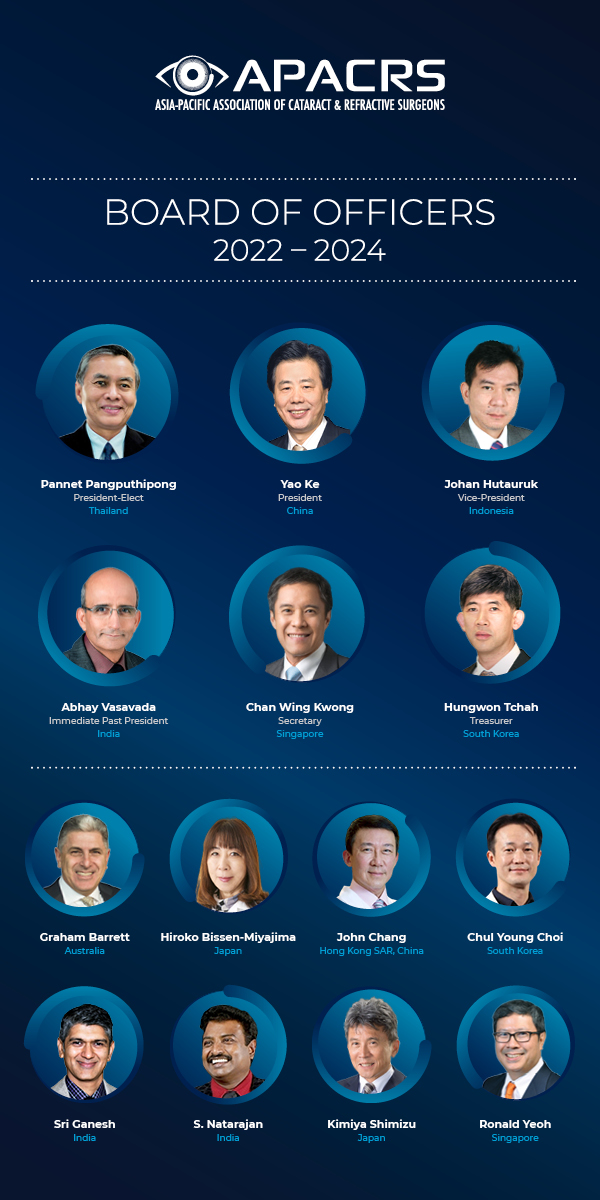
 EyeSustain Update
EyeSustain Update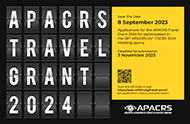 2024 APACRS TRAVEL GRANT
2024 APACRS TRAVEL GRANT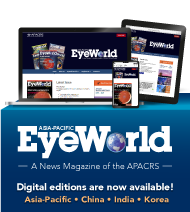 Digital EyeWorld
Digital EyeWorld VOL. 39 (2023), ISSUE 3
VOL. 39 (2023), ISSUE 3  Membership Information
Membership Information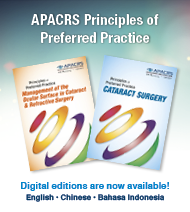 APACRS Principles of Preferred Practice
APACRS Principles of Preferred Practice